Outside the O.R.: How Medical Robots are Transforming Healthcare
Medical robots are usually synonymous with surgical robots, which dominate robotics applications in healthcare. However, robot adoption is increasing in other areas of care delivery and hospital management.
With people living longer and a growing shortage of healthcare workers, there is increased demand for personal robots, including ‘care-bots’, which could serve as companions for the eldery or assist in activities of daily living. Similarly, rehabilitation robots, which can be used in acute therapy settings or in the home, could revolutionise how we treat and care for those with limited function due to aging or physical challenges.
As hospitals take care digital, they can also use telepresence robots to enable better access to specialists. Hospital administrators and pharmacy managers may also turn more to robots to automate repetitive logistics tasks, including transport of supplies, cleaning, and drug dispensing.
In our continuing series on the robotic marketplace, we take a deeper dive into the field of medical robotics. In this post, we survey how robots are moving from the OR to the halls of the hospital to homes, supporting provision of medical care and changing how patients receive it.
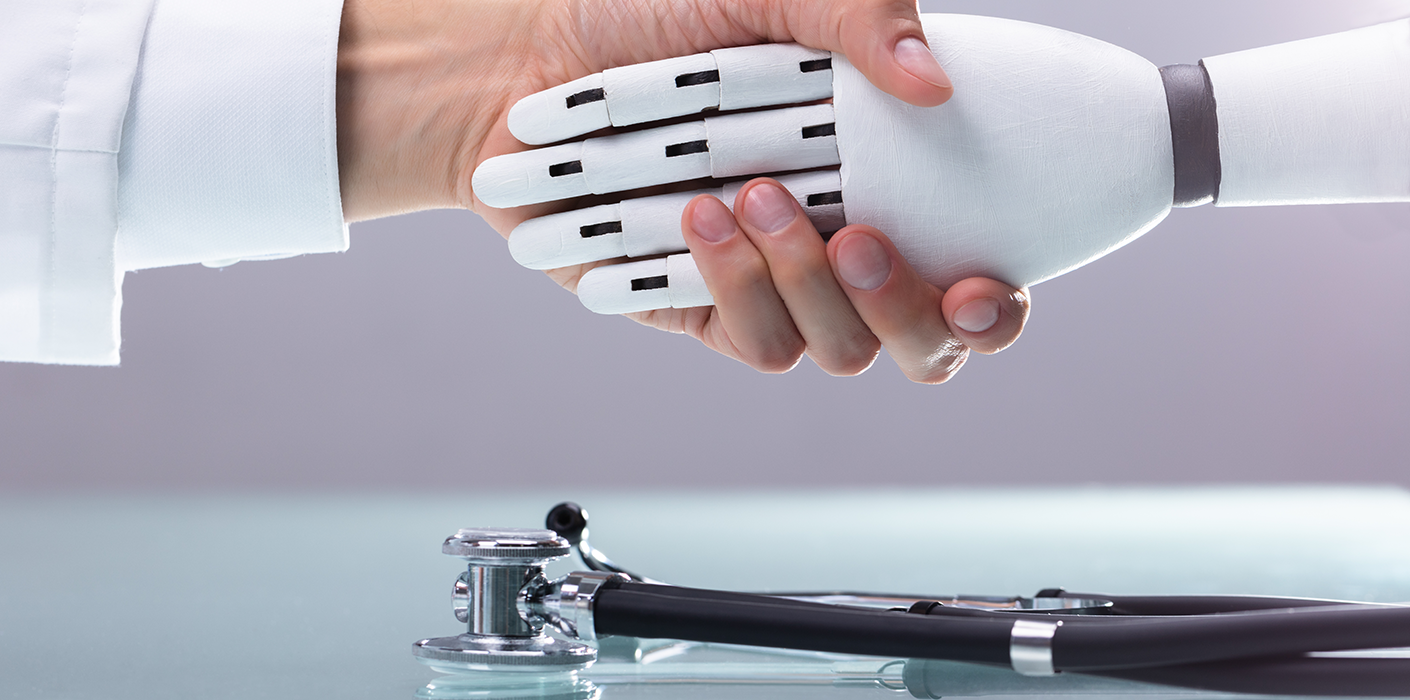
Rehabilitation and Assistive Robots
The rehabilitation robotics market, which includes robots used in care settings as well as for assisted living, is expected to grow to $1.1 billion by 2021. Research has shown that robot-assisted rehabilitation can reduce the burden for therapists and improve movement in extremities compared to conventional therapy.
Rehabilitation robots include robotic end-effectors, such as the Watertown-based Bionik’s InMotion Arm and robotic exoskeletons, like the EksoNR from Ekso Bionics. These robots are used during physical therapy to monitor patient movement and gently assist patient movement with customized and adaptive postural and motor support.
Virtual reality is also being tested with these robotic systems to better deliver performance feedback to patients and increase patient motivation, and in some research has been shown to be more effective than conventional therapy for upper limb rehabilitation.
Robots can also serve as assistive technologies for patients with chronic conditions that limit their mobility. ReWalk Robotics offers a bionic walking assistance system with powered leg attachments that enable paraplegics to stand upright, walk and climb stairs. Robotic prosthetics, such as the powered ankle prosthetic we developed with MANTA client BionX, use a combination of sensors and actuators to restore biologically accurate motor patterns to patients who have lost limbs.
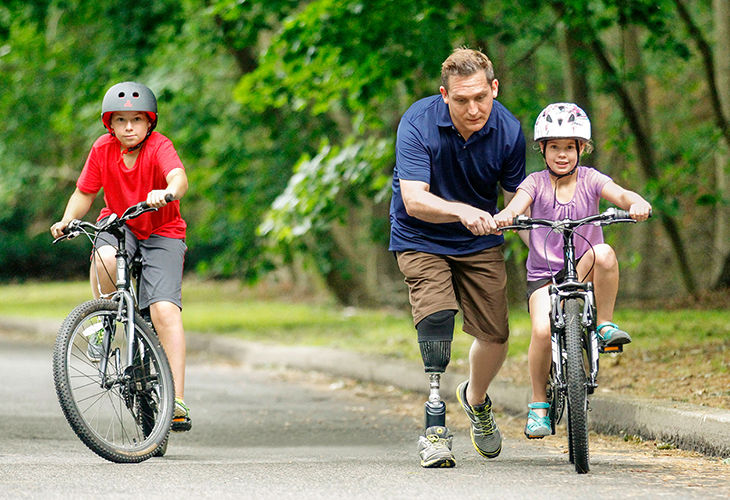
MANTA client BionX's robotic ankle prosthetic uses a combination of sensors and actuators to assist amputees in walking.
Companion and Care Robots
By enabling independent living and potentially reducing emergency hospitalization rates, companion and care robots could revolutionize life for an aging population 'Care-bots developed by companies such as Kompai Robotics, can converse, remind people of meetings, and keep track of shopping lists, much like a conventional home smart speaker. However, their functionality also surpasses conventional consumer robots: monitoring for falls, providing health alerts, and connect to providers and caregivers via video-conferencing.
As with consumer robots and those in the public environment, care robots require advanced cognition and natural language processing for effortless interactions with humans. Especially for robots involved in sensitive care, designers must avoid the “uncanny valley” that an anthropomorphic robot can take. In designing ReThink’s Baxter and Sawyer robot, MANTA designers had to navigate creating a form and display that could be approachable and communicate the capability of the robot, without veering into a design that could trigger a negative emotional response.
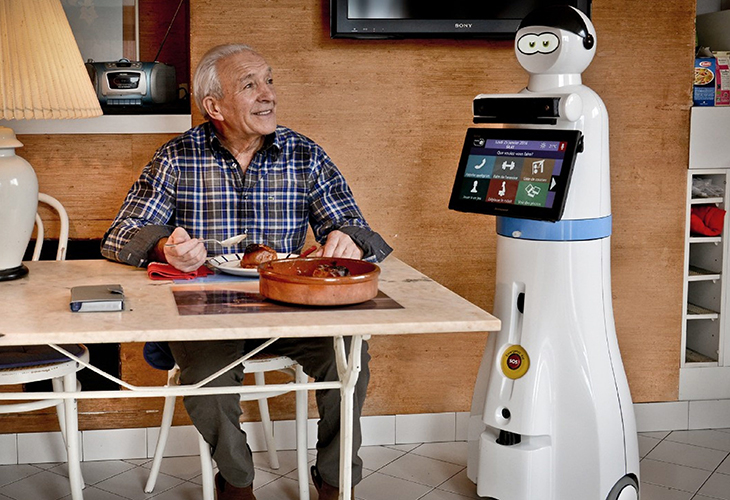
The Kompai companion robot provides connection to those in need of assisted living, while also performing key health functions such as fall monitoring. Image courtesy Kompai Robotics.
Telepresence Robots
While widespread telehealth adoption in the U.S. has historically faced many obstacles, the coronavirus pandemic lowered these barriers. Medical telepresence robots, which can enable remote consultation at various points in a hospital, require autonomous navigation capability and sophisticated cameras to be able to perform directed physical examinations.
Ava Robotics combines video conferencing with an autonomous mobile robotic base, like those used in logistics and fulfillment. Unlike other AMRs, Ava’s robot feature set is tailored to a hospital environment, with HIPAA-certified communications system and an enclosure that is easy to sterilize, helping prevent cross-contamination. Not only do these robots allow providers in any location to see patients, but they also benefit hospitals by reducing strain on PPE supply.
Even as telepresence robots facilitate access to care, patients have raised concerns that their overuse interferes with the physician-patient relationship, and ethicists advocate that they be used primarily to connect physicians with each other. MANTA’s user researchers and designers can illuminate stakeholder perspectives around telepresence robots, articulate clear use cases, and facilitate designs that empower this patient-physician relationship, rather than strain it.
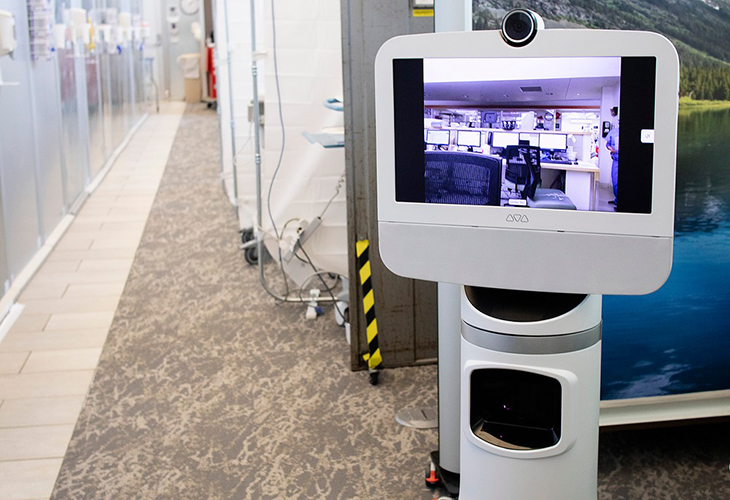
With the onset of the coronavirus pandemic, Cambridge-based Ava Robotics was able to deploy its telepresence robot in hospitals to help keep patients and healthcare workers safer while maintaining a continuum of care. Image courtesy Ava Robotics.
Medical Transport Robots
Like transport robots used in inventory management, medical transport robots can deliver supplies, medications, and lab specimens around the hospital. Similar to telepresence robots, their navigation systems must be robust enough to maneuver around the semi-structured, dynamic environment of a hospital. They provide an added benefit to hospital operations by integrating with IT systems for secure and accurate tracking of inventory, similar to RFID-enabled medical inventory systems MANTA developed for CardinalHealth.
The Aethon Tug, an autonomous mobile robot that can transport food, supplies, and medication, currently dominates this space. Using lasers and infrared and ultrasonic sensors, it navigates and avoids collisions, while also speaking and emitting tones to alert people to its presence. Its medicine delivery model, like other medical carts, contains closed drawers requiring PIN and fingerprint from personnel at its designated destination before it can be opened.
While Tug’s design is friendly, Diligent Robotic’s took an alternative approach with Moxi, a social humanoid robot for medical delivery and restocking. Moxi’s form reflects its human-guided learning approach, in which the robot uses perceptual cues to initiate different manipulation skills and grasp strategies for different categories of objects. In our work with robotic picking systems, MANTA engineers have harnessed vision software systems and tested various end-effectors to train robots to pick items of different shapes and sizes.
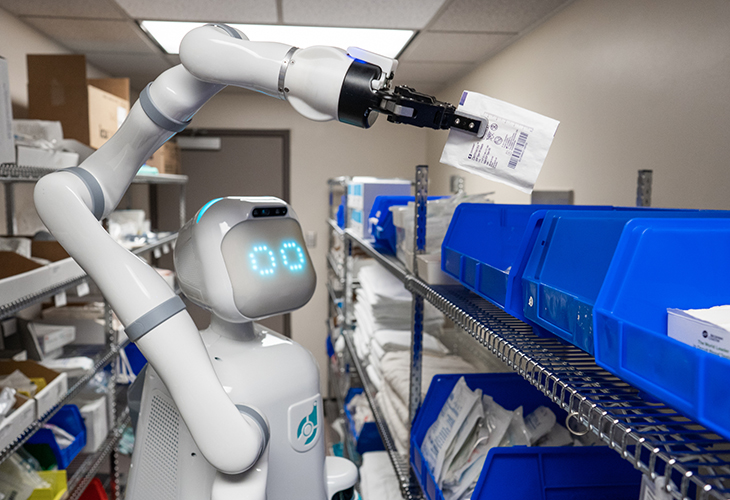
Diligent's Moxi Robot serves to pick, transport, and deliver medical supplies around the hospital and has a humanoid form that emphasizes its additional social functions. Image courtesy Diligent Robotics.
Sanitation and Disinfection Robots
Likewise boosted by the pandemic, disinfection robots like those made by Xenex are being used in hospitals for disinfection and sanitation. Consisting of arrays of pulsed xenon UV-C lights that destroy viral RNA, these robots use guided or autonomous navigation to emit sufficient light that a large room can be disinfected within 20 minutes. While chemical cleaning products are effective, using them to disinfect larger, potentially high-risk hospital areas can be expensive, dangerous, and time-consuming. Robotic cleaning is not only less resource and time-intensive, it can also gather data on cleaning and infection rates, which is crucial for hospitals trying to contain infections.
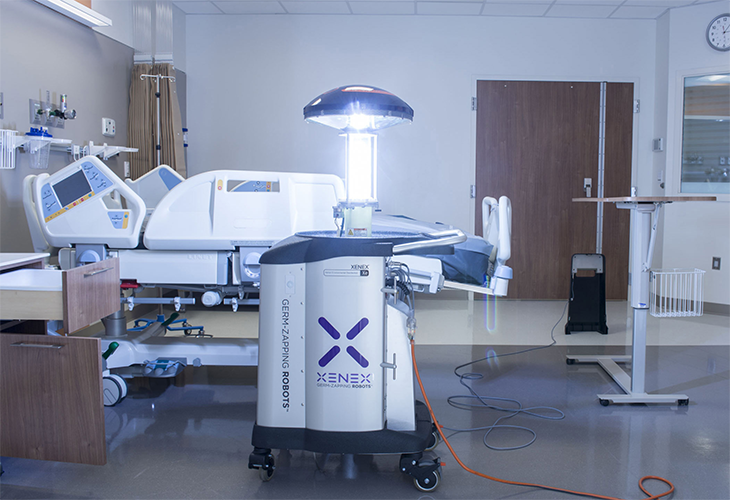
The Xenex Light-Strike Robot is currently being deployed to disinfect hospitals of airborne pathogens, includings SARS-CoV2. Image courtesy Xenex robotics.
Prescription Dispensing
Drug-dispensing errors are a leading pharmaceutical error, and one that robots can help correct while also improving pharmacy’s operational efficiency. The speed and precision robots offer frees up pharmacists to perform more patient-facing tasks, and is a particular benefit to areas where trained technicians are in short supply.
Dispensing robots, like McKesson’s Robot-Rx, consist of robotic arms that integrate with a pharmacy benefit management system, and can identify the correct vial and drug when an order is placed. The robot also automates pill counting and vial labeling, using barcode scanning throughout to ensure the correct drug is given to the patient.
Such robots require sophisticated engineering and durable enclosures that can keep both human users and the machine safe. Working with PerkinElmer on the Vectra Polaris, an automated, high-throughput cellular imaging system with robotic mechanisms, MANTA successfully developed a small-footprint system that ensured user safety at any interaction point.
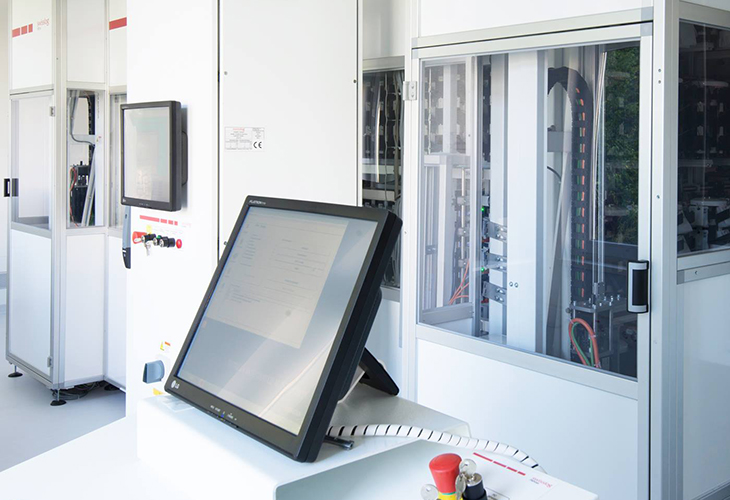
Pharmacy robots like Swisslogic's PillPick help reduce the chance of dispensing the wrong medication, and use barcode scanning to ensure patients get their appropriate medication. Image courtesy Swisslogic.
Surgical Robots
Surgical robots continue to dominate the medical robotics segment, with robotic-assisted surgeries in the U.S. leading the rest of the world in volume of robot-assisted surgeries.
Primarily used in minimally invasive endoscopic procedures, systems like Johnson & Johnson’s Auris Monarch and Corindus’ CorPath GRX, are often offered as complete platforms incorporating imaging, multi-modal visualization, and intra-operative navigational guidance with ergonomic robotic control consoles.
The touted benefits of such systems include 3D visualization, better access to hard-to-reach areas, and increased precision and dexterity. In developing the Medrobotics Flex Robotic System, a first-in-class bio-inspired flexible scope, we enabled surgeons to operate in places that were previously inaccessible via a minimally invasive approach.
Though robotic surgery is becoming more common, the field is still developing, both in technology that can improve patient outcomes and design that can hasten health system adoption. In our next post, we’ll take a closer look at the future of robotic surgery.
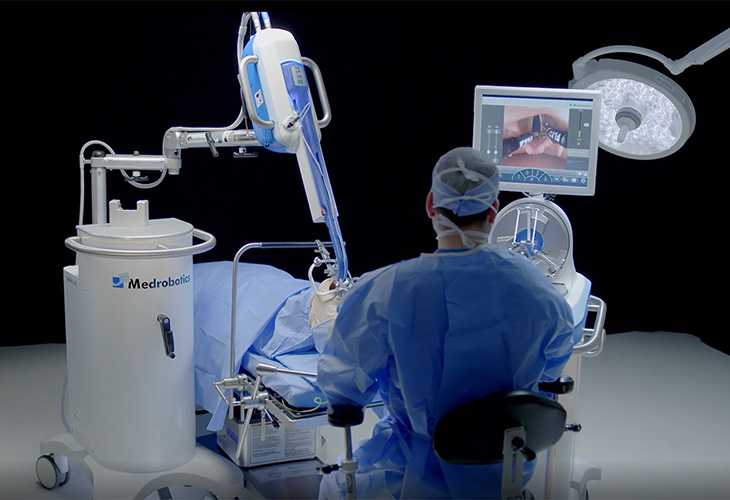
With our client Medrobotics, we developed a flexible robotic endoscope with an integrated camera, custom tools, and an ergonomic console.
How Will Your Robot Transform Healthcare?
Our experienced team of researchers, designers, and engineers can help you create a standout user experience, elegant form factors, and cutting-edge engineering solutions for your medical robot. Contact us today to begin developing your project plan.
